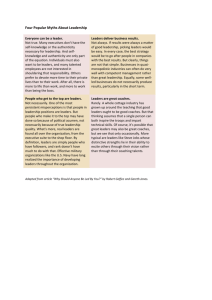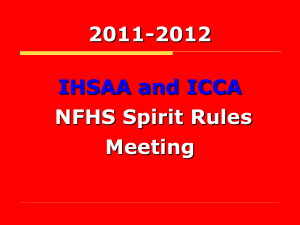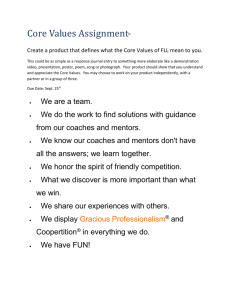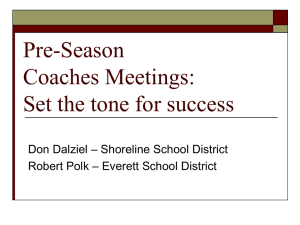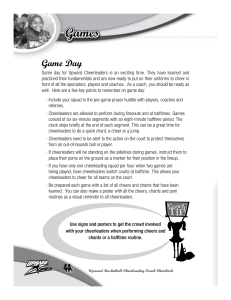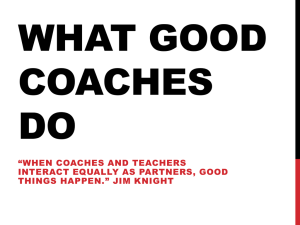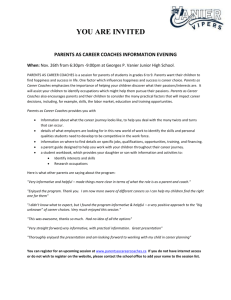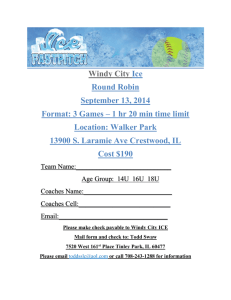NFHS Spirit Rules 2006-2007 - Iowa High School Athletic Association
advertisement
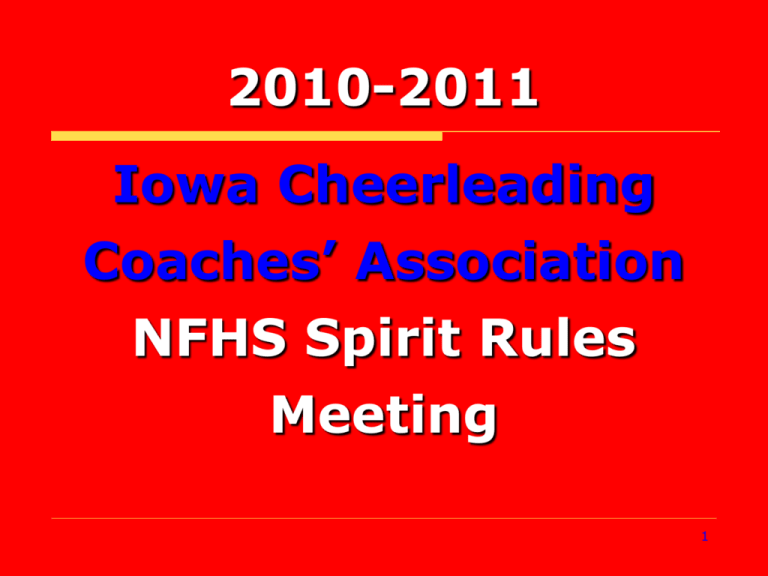
2010-2011 Iowa Cheerleading Coaches’ Association NFHS Spirit Rules Meeting 1 Please Note! This PowerPoint DOES NOT take the place of coaches reading and knowing the rules! This presentation should only be used as a reference. It is the coach’s responsibility to make sure stunts are legal. Don’t rely on your choreographer to know the rules. 2 Following the Rules These rules are for ALL Iowa cheerleaders (grades 7-12), not just the cheerleaders of coaches who are ICCA members! All cheerleaders are required to comply to all NFHS spirit rules in all situations. Practices Competitions Pep Rallies Exhibitions & Performances Sideline and Halftime Performances 3 National Federation Rules The National Federation of State High School Associations has led the development of education-based interscholastic sports and activities that help students succeed in their lives. Rules Rules Rules Rules Rules provide direction. build awareness. support activities. improve activities. establish a consistent standard. 4 Following the NF Spirit Rules Rule 2-1-1 “A coach must not permit a team member to participate if in the judgment of the coach, the participant does not conform to the NFHS rules.” The purpose of the NFHS Spirit Rules is to minimize risk to the participants. For this reason, coaches need to make sure the rules are followed even if the cheerleaders and/or their parents don’t agree with them. The NF rule book is legally defendable as long as coaches are following the rules, which includes participant readiness. 5 Awareness of Individual and Team Limitations As with any athletic activity, the coach is responsible for enforcing general risk management rules, recognizing a teams’ particular ability level, and ensuring that team members follow progressions. Only those skills mastered in practice by being consistently executed safely and correctly should be performed in public. Coaches are accountable for approving and documenting mastery of skills before allowing participants to progress to the next level or to perform skills in public. Elite level stunts can be performed safely when appropriate progressions are followed and team members are properly trained and prepared. 6 Cheerleaders as Athletes Cheerleading is an athletic activity. It’s up to coaches to make sure that this image of cheerleading is upheld. Coaches should remain cognizant of this image when choosing cheerleading uniforms and approving cheer/dance movements and words for their cheerleaders to perform. 7 Rules Book Layout Rule Changes with Rationale Points of Emphasis Table of Contents Index (p. 7) Philosophy (p. 9) Rule 1 – Definitions (p. 10) Rule 2 – General Risk Management (p. 14) Situations (p. 24) – help clarify the rules Rule 3 – Dance/Drill/Pom Risk Management (p. 35) Pictures (p. 44) – help clarify the rules Suggested Guidelines for Management of Concussions (p. 73) Handling Contests During Lightning Disturbances (p. 76) Coaches’ Code of Ethics (p. 77) 8 Rule Section Organization Each rule has sections and articles. New/revised rules are shaded. Rule 2 & 3 sections and articles typically have a situational ruling (look for * by a rule). The back of the book has photographs covering some rules/sections/articles (look for P by a rule). 9 NFHS Spirit Rules Spirit Rules Changes for 2010-11 10 Rule 2-1-15 An athlete who exhibits signs, symptoms or behaviors consistent with a concussion (such as loss of consciousness, headache, dizziness, confusion or balance problems) shall be immediately removed from the contest and shall not return to play until cleared by an appropriate health-care professional. (Please see NFHS Suggested Guidelines for Management of Concussion on page 73). 11 Rule 2-2-8 Supports, braces, etc., which are hard and unyielding or have rough edges or surfaces must be padded with a closed–cell, slow recovery foam padding no less than one-half inch thick. Padded knee and ankle braces which are unaltered from the manufacturer’s original design/production do not require any additional padding. A participant wearing a cast (excluding a properly covered air cast) must not be involved in a stunt. 12 Rule 2-2-8 Supports & Braces Comment: Clarification from NFHS Sports Medicine Advisory Committee for all NFHS rules books. 13 Rule 2-6-7 Add exception: 1 ¼ twists are permitted from side-facing stunts. Comment: Twist cradles from side-facing stunts present only minimally more risk than single twists. The extra ¼ twist allows the flyer to face forward before completing the rotation. This is consistent with 2-13-2, which allows an extra quarter-turn in double twisting cradles. 14 Rule 2-6-7 Double Downs To be consistent with Rule 2‐13‐2, there was an exception added to Rule 2‐6‐7 regarding stunts involving twists. During stunts, participants are now permitted to do 1 ¼ twists from side‐facing stunts. 15 New Rule 2-8-14 Suspended splits involving bracer(s) that originate at any height and drop to any level are legal provided all the following conditions are met: 16 Rule 2-8-14 Suspended Splits a. b. c. d. The flyer has both hands in contact with the bracer(s). The flyer does not become inverted. The flyer has at least two bases. The flyer and bracer(s) each have a separate spotter. Exception: Bracers in shoulder sits or thigh stands. e. In suspended splits when the flyer is not released by the bases, the bracer(s) must maintain hand/arm contact with the flyer until she/he is no longer in a split position. f. In suspended splits when the flyer is released by the bases, the release must be a continuous vertical up-anddown movement in which the flyer remains over the base(s). The bracers must maintain hand/arm contact with the flyer during the entire loss of contact with the bases. (Note: See 2-12-1) 17 Rule 2-8-14 Suspended Splits COMMENT: Bracers are frequently used in many types of stunts. This rule allows a flyer in suspended splits to have contact with bracer(s) rather than with base(s). 18 Rule 3-1-6 Added Exception: Dance paws and pedini-style dance shoes that have heels of sufficient height to raise the bottom of the foot off the floor. COMMENT: Dance paws allow movement of the foot without compromising the look and feel of barefoot dancing. Dance paws also help protect the foot by preventing friction burns and skin tears. 19 New Section 3-7 Assisted inverted floor stunts are legal provided both the following conditions are met: a. The inverted participant is in direct, weight-bearing contact with the performing surface and provides primary self-support throughout the stunt. b. The assisting non-inverted participant is in direct, weight-bearing contact with the performing surface and provides only partial support for the inverted participant. COMMENT: Assisted floor stunts are becoming common, especially in hip hop routines. Previously, the only reference to this type of stunt was a situation/ruling in Rule 2. 20 Major Editorial Changes 21 Rule 2-6-12a a. The flyer maintains hand-tohand/arm contact with at least one bracer until the flyer is descending. This editorial change now allows bracers to let go of the flyer once she/he is descending instead of trying to hold on and possibly becoming inverted. 22 Rule 2 - Section 12 Section 12 has been reorganized to help clarify transitional stunts for coaches. The section is divided into: 2-12-1 Release transitions 2-12-2 Non-release transitions that involve changing bases 2-12-3 Non-release transitions that do not involve changing bases All aspects of a transition stunt MUST be legal. Interpreting the Legality of Stunts www.iowacheercoaches.org 23 Points of Emphasis Concussions Double Downs Jewelry Coach & Participant Responsibilities 24 Points of Emphasis Concussions 25 Suggested Guidelines for Management of Concussion A concussion is a traumatic brain injury that interferes with normal brain function. An athlete does not have to lose consciousness (be “knocked out”) to have suffered a concussion. 26 Suggested Guidelines for Management of Concussion Common Symptoms of Concussion Include: Headache Fogginess Difficulty concentrating Easily confused Slowed thought processes Difficulty with memory Nausea Lack of energy, tiredness Dizziness, poor balance Blurred vision Sensitive to light and sounds Mood changes – irritable, anxious, or tearful 27 Suggested Guidelines for Management of Concussion Suggested Concussion Management: 1. No athlete should return to play (RTP) or practice on the same day of a concussion. 2. Any athlete suspected of having a concussion should be evaluated by an appropriate health-care professional that day. 3. Any athlete with a concussion should be medically cleared by an appropriate health-care professional prior to resuming participation in any practice or competition. 4. After medical clearance, RTP should follow a stepwise protocol with provisions for delayed RTP based upon return of any signs or symptoms. 28 Prevention Although all concussions cannot be prevented, many can be minimized or avoided. Proper coaching techniques and good officiating of the existing rules can minimize the risk of head injury. It is strongly suggested that all coaches view “Concussion in Sports,” at www.nfhslearn.com. 29 Points of Emphasis Double Downs 30 Double Downs It has been stressed to spirit coaches that they are responsible for teaching and enforcing general risk management rules, identifying teams’ ability levels, and following proper progressions in learning new skills. It is the NFHS’s responsibility to revise rules to minimize risk whenever trends indicate a continuation of poor execution of skills resulting in injuries. 31 Double Downs For this reason, the NFHS is calling attention to the fact that double downs/twists will no longer be allowed at the high school level after this year if coaches continue to allow athletes to perform this skill with improper technique. 32 Double Downs In order to retain double downs/twists in the future, it is imperative that coaches insist upon “perfection before progression” when allowing teams to stunt. It is suggested that middle school/junior high cheerleaders NOT perform double downs/twists. 33 Points of Emphasis Jewelry 34 Jewelry Spirit coaches are expected to follow the rules written for the safety of all participants of cheerleading and dance. The spirit rules regarding jewelry (2-2-1 and 3-1-2) apply to all spirit activities, which includes both practices and performance events. * Nose piercings are not allowed. It is not acceptable to cover any piercing with tape or fill any piercing with a spacer or clear stud. 35 Jewelry It is the coach’s responsibility to teach and enforce this rule. Recent fashion trends have coaches and participants questioning this simple ruling with unnecessary challenges. 36 Jewelry With the exception of religious and medical medals, examples of jewelry include, but are not limited to: necklaces, bracelets, rings, all facial and body piercings (includes spacers and fishing line), wrist bands, corsages, and hair ties on wrists. This rule is consistent with rules concerning jewelry in the NFHS rule books for other athletic activities. “No jewelry” means NO JEWELRY. 37 Iowa Cheerleaders Wearing jewelry was by far the most frequently violated rule by Iowa cheerleaders this past year. *Note: Hair ties on wrists are illegal! Lack of consistency by coaches at all times is the most common reason that the jewelry, hair, nail, and gum rules are violated. 38 Points of Emphasis Coach and Participant Responsibilities www.nfhs.org 39 Coach and Participant Responsibilities The links below list guidelines to serve as useful reminders of basic procedures for both coaches and participants of spirit teams. Coaches’ Responsibilities *This site includes Partner Stunt Progressions and Tumbling Skill Levels. http://www.nfhs.org/content.aspx?id=3084 Participants’ Responsibilities http://www.nfhs.org/content.aspx?id=3085 40 Rules Book Correction p. 60 Suspended Splits 41 Major Editorial Changes Page 60 had the same exact rule as listed on page 61. The IHSAA has placed a label with the correct rule (2-8-13 from page 20) over the incorrect rule. 42 43 Medical Appliances When it is necessary for an athlete to wear a medical appliance (such as an insulin pump) during athletic competitions, the device shall be padded and securely attached to the player’s body underneath the uniform. Devices attached to the head (such as hearing aids and cochlear implants) do not need to be padded, but shall be firmly secured to the body. No medical appliance should pose a risk of injury to others. It is recommended that the athlete notify the official of the presence of the medical appliance prior to a contest. 44 Security Practice plan Event plan School policies Administration crisis plan Plans are in place for emergencies, weather alerts, fire, power outages, hostile crowds, transportation, evacuation, accidents, etc. 45 Guidelines on Handling Contests During Lightning Disturbances Proactive Planning Assign a staff member to monitor local weather conditions before and during events. Develop an evacuation plan, including identification of appropriate nearby shelters. Develop criteria for suspension and resumption of play: a. When thunder is heard, or a cloud-to-ground lightning bolt is seen, suspend play and take shelter immediately. b. Once play has been suspended, wait at least 30 minutes after the last thunder is heard or flash of lightning is witnessed prior to resuming play (30-minute rule). c. Any subsequent thunder or lightning after the beginning of the 30-minute count, reset the clock and another 30-minute count should begin. Hold periodic reviews for appropriate personnel. 46 ICCA Information 47 NF/ICCA/IHSAA SPIRIT RULES This information is on the ICCA website - www.iowacheercoaches.org It was also included in the fall mailing. NFHS Spirit Rule 2-2-2: “Fingernails, including artificial nails, must be kept at an appropriate length (short, near the end of the fingers) to minimize risk for the participants.” ICCA/IHSAA addition: “All nails, including artificial nails, must be cut to a length so that the nail is not visible when the cheerleader holds up her/his hands from the palm side. This is what is considered safe.” NFHS Spirit Rule 2-2-3: “The hair must be worn in a manner to minimize risk for the participant. Hair devices, if worn, must be secure and appropriate for the activity.” ICCA/IHSAA addition: “All cheerleaders’ hair must be pulled away from the face and off the shoulders: i.e. ponytail. This would be for both stunting and nonstunting squads.” NFHS Spirit Rule 2-2-7: “Glitter that does not readily adhere on the hair, face, uniform, costume, or the body is illegal. Glitter may be used on signs, props, or backdrops if laminated or sealed.” ICCA/IHSAA addition: “No spray on/roll on glitter. Glitter in eye shadow should be minimal.” NOTE: These rules will be in effect for ALL Iowa school (grades 7-12) events, including practices, games, meets, tournaments, competitions, and all other events in which school cheerleaders participate. 48 Competitions If you attend a competition and the National Federation Spirit Rules are not being followed (some competitions say they’re following them but they really don’t), you may be found liable if your cheerleaders don’t follow the rules while participating and get hurt (illegal stunts, spring floors, etc.). Coaches are reminded that not all stunts seen on television, online at cheer company sites, and/or YouTube are legal including stunts in routines at national competitions. This is why it’s important for all coaches to know, understand, and follow the NF rules. The only activities where cheerleaders are covered by the IHSAA catastrophic insurance are IHSAA sponsored events (which includes the ICCA events) as long as cheerleaders are following the National Federation Spirit Rules. Cheerleaders are not covered by the IHSAA at other competitions! 49 Clarifying the Hair Rule Hair must be secured away from the face. If cheerleaders move their heads, their hair needs to stay out of their faces. It is not legal for cheerleaders to use their hands to move their hair away from their faces. Hair tucked behind the ears is not legal, because hair is not secured in this situation. Short hair that could be in the face needs to be secured back. Bangs pulled across the forehead, wispies, & chunks of hair beside the face all need to be and stay out of the eyes. Anytime hair gets in the way of a stunt, it’s illegal. Hair should be off the shoulders for stunting. Note: Bumpits are illegal. More information regarding the hair rule is on the ICCA website www.iowacheercoaches.org 50 Additional Rule Information Additional rule information can be found on the ICCA website. Coaches are responsible for this information, also. www.iowacheercoaches.org Rules Most Frequently Violated Clarifying the Hair Rule State Rules Regarding Number of Cheerleaders for Playoff Events Interpreting the Legality of Stunts 51 Integrity of Coaches We need to rely on the professional integrity of our coaches to make sure all rules are followed. Coaches must take care of their own cheerleaders so others won’t need to address the rules with them. Coaches should accept responsibility if their cheerleaders are at fault, rather than blaming others, including those who address the rules violation(s). 52 Preventing Rules Violations Be proactive to help prevent rule violations at your school. Coaches and cheerleaders should welcome visitors to their school and remind them of the rules before they begin cheering. Our intent isn’t to “catch” cheerleaders not following the rules. Coaches should talk to the cheerleading coach and/or appropriate administrator of the school in violation of the rules in a courteous manner before reporting the rule violation(s). 53 If You See a Rule Violation Ask cheerleaders if their coach is present and, if not present, who is responsible for them. Be sure YOU see the violation and it’s not one just reported to you by your cheerleaders. Let the coach know that following the NF rules is important for the safety of the cheerleaders and the liability of the coach and school. All schools in Iowa must follow these rules because they’ve been adopted by the IHSAA and ICCA for the safety of Iowa cheerleaders. Remember to be calm, positive, and tactful when addressing rule violations with cheerleaders and coaches. 54 Reporting Rule Violations Report violations immediately to: Jeanne Ehn (jehn@heartofiowa.net) or Nancy Huether (nhuether@huxcomm.net) so violations can be handled in a timely manner. Their emails are also available on the ICCA website. Only coaches who have attended a rules meeting may report violations. 55 When Rules Are Violated When a school is reported for a rules violation the first or second time, both the coach and one of the school’s administrators will be contacted by Jeanne Ehn or Nancy Huether. If a school violates the National Federation rules for a third time, the IHSAA will contact the school. Continued violation of the rules could lead to a cancellation of catastrophic insurance coverage for that school by the IHSAA. 56 Rule Interp Contact Information Donna McKay 842 7th St. SE Mason City, IA 50401 jdmckay4@mchsi.com (on the ICCA website) All rule questions should be directed to Donna McKay ONLY AFTER you have tried to find the answers in the rules book and/or the Interpreting the Legality of Stunts sheet. For the State Competition, please send a video or DVD requesting a legality interpretation of a specific stunt(s). Entire routines will not be reviewed! The rules interpretation deadline for the State Competition is Saturday, October 23. 57 Information Reminders The fall mailing was sent out to all Iowa high schools in late July/early August. It contained the NF Rules Book, ICCA event paperwork, and other information. Paperwork deadline for State, Honor Squad, All-State Postmarked by Tuesday, September 28 ICCA Coaches’ Conference – Ames Friday, April 8 – Saturday, April 9 ICCA Website www.iowacheercoaches.org Extra rules books may be obtained from Elisa Kahler at the IHSAA for $10.00 each. 58 NFHS Coach Education www.nfhslearn.com Fundamentals of Coaching First Aid for Coaches AACCA Fundamentals of Coaching Cheer & Dance Take Part. Get Set For Life! 59 Professionalism Read the rule book and situations, including the notes and comments, to minimize risk. ALWAYS follow the rules and their intent. Comprehend rules to safely and correctly teach appropriate skills. Ensure your cheerleaders are following the rules. Be a role model. Take classes to increase your cheer coaching knowledge. Be an advocate for sportsmanship. Be a member of your professional organization (ICCA). 60 Thank You For Your Time! We look forward to seeing you at ICCA events! We hope you have a safe and rewarding cheer year! 61
